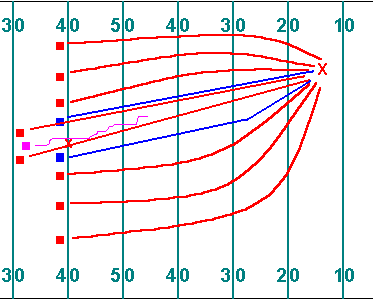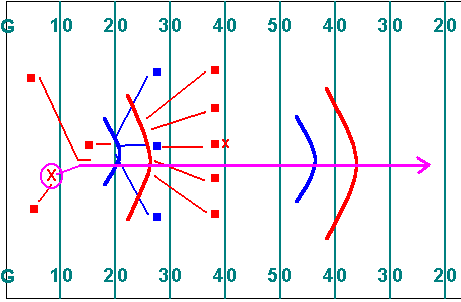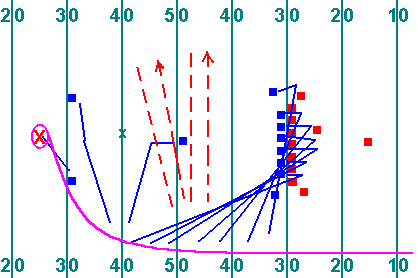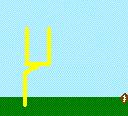Special
Teams.
.
.
The Kick Off
There are many possible formations
when kicking the ball off to the receiving team. Regardless of the
actual alignment, the eleven men of the kickoff team line up at the line
of scrimmage. Personally, I favor the method of keeping two "head hunters"
back with the kicker. This allows these players to gain full stride
at the line of scrimmage when the ball is kicked and speeds their progress
to the ball. Often a coach will specify one, two, even three inside
linemen specific duty to be the "wedge  busters."
These player's first objective is to destroy the wedge, breaking down the
returning team's blocking scheme. The one true golden rule
of the kick off team is for a player to stay within the specified lane
assigned. Routes to the ball carrier should be taken at such an angle
as to deter a returnee from changing directions. While running down
the field to tackle, the members of the kicking team should keep the ball
carrier to the inside shoulder, never allowing the ball carrier to the
outside shoulder of the would be tackler. The outside player to each
side has ultimate containment responsibility. The kicker is the safety,
the last tackler.
busters."
These player's first objective is to destroy the wedge, breaking down the
returning team's blocking scheme. The one true golden rule
of the kick off team is for a player to stay within the specified lane
assigned. Routes to the ball carrier should be taken at such an angle
as to deter a returnee from changing directions. While running down
the field to tackle, the members of the kicking team should keep the ball
carrier to the inside shoulder, never allowing the ball carrier to the
outside shoulder of the would be tackler. The outside player to each
side has ultimate containment responsibility. The kicker is the safety,
the last tackler.
Kick Off Returns
I employ five types of kick off return teams. They are the standard
Wedge,
the Wall, the Reverse, the Anything
Goes (desperation), and the Hands Team. The Wedge calls
for 5 linemen up front, ten yards from the ball as the first wall.
These linemen are seldom the largest on the team, as both size and
speed are requirements for inclusion to the kick off team--an honored position
on my team. The second wall has three players. These players
are usually of the linebacker, tight end, or fullback variety. An
up back, and two deep backs round out the formation. The front line's
primary responsibility is to ensure the ball is in fact kicked deep.
After verifying the kick, the center turns his back to the kicking team
and sprints back towards the deep backs looking directly at the up back.
When the up back points to, or otherwise signals the center, the center
turns around and starts back up field. The two guards to each immediate
side of the center do not turn their backs to the kicking team. Instead,
they run diagonally back narrowing their relative proximity to the center.
The tackles do the same, narrowing down the gaps from the guards.
When the center turns around, the other four linemen come shoulder to shoulder
and sprint up field presenting a unified front, or wedge of massive bodies.
Their responsibility is not to single out individual defenders to block,
rather it is to maintain the wedge and progress rapidly up field.
The first line should never drop back past the 25 (or 20) yard line before
racing back up field.
The second line back peddles no more than 10 yards
and forms a second wall joined by the up back and the non receiving deep
back. This second wall fills any gaps created in the wedge and picks
off specific tacklers as they threaten the wedge, particularly from the
flanks.
The ball returnee falls in behind the wedge seeking
and willing to follow the mass of bodies up field, but remains poised and
ready to explode through any presenting gap or seam that might become available.
The wedge can be run regardless of where the kick goes, as the ball carrier
can run to the wedge. Shown below is a diagram
of the theory of the Wedge.

 The Wall
Kick Return attacks up the side line rather than up the middle of the
field. The wall can best be used when the kick is to the one side of the
field, but can easily be run even if the kick is straight. All the
blockers except for the two farthest from the returnee race to the side
line. The front five sprint back 10 yards then the closest three
race to the side line at the front of the wall. The outside two line
men "lag" behind and form a cut back lane for the returnee, picking off
would be tacklers as they cut back with the runner. Players forming
the wall do not run squarely up field. Rather, they shuffle up field
shoulders parallel to the side lines, hands extended. Their objective
is not to extend and block, but to present an obstacle for would be tacklers.
The non receiving deep back leads the returnee up field, his main objective
being to remain on his feet and in front of the ball carrier. The
diagram here shows the theory of the Wall Return.
The Wall
Kick Return attacks up the side line rather than up the middle of the
field. The wall can best be used when the kick is to the one side of the
field, but can easily be run even if the kick is straight. All the
blockers except for the two farthest from the returnee race to the side
line. The front five sprint back 10 yards then the closest three
race to the side line at the front of the wall. The outside two line
men "lag" behind and form a cut back lane for the returnee, picking off
would be tacklers as they cut back with the runner. Players forming
the wall do not run squarely up field. Rather, they shuffle up field
shoulders parallel to the side lines, hands extended. Their objective
is not to extend and block, but to present an obstacle for would be tacklers.
The non receiving deep back leads the returnee up field, his main objective
being to remain on his feet and in front of the ball carrier. The
diagram here shows the theory of the Wall Return.
The Reverse simply calls for calling and
blocking to one side, then the non receiving deep back takes the hand off
from the original receiver. The new ball carrier runs without blocking
support to the opposite side line much like a quarterback boot leg.
The Anything Goes is a practiced series of
laterals in desperation mode which may include a huddling of the up back
and the two deep backs after the reception in order to hand the ball to
a 'secret' ball carrier.
The Hands Team calls for the replacement
of the front five linemen with receivers and backs designed to thwart an
obvious oncoming onside kick from the opposition.
Punt Returns
The Punt Return team can use the wall method as well with only slight
modification.  The
down linemen make contact with the blockers, sustaining contact until the
ball is kicked. Then the linemen sprint in reverse order to the predetermined
sideline--as in punt return right. Linemen furthest from the sideline
race to the forward positions of the wall and follow blocking procedures
outlined in the Wall Return. Linemen closest
to the play assume the nearest positions to the ball carrier. The
up back (20 yards from the line of scrimmage) and the non receiving deep
back are responsible for the two men on offense eligible to release down
field prior to the kick. In the event the ball is kicked to the opposite
side line the return is called, the wall comes directly across the field
at a right angle allowing the returnee to use their bodies as posts or
picks to cut off pursuing tacklers. As in all kick returns, the "Eyes
Rule" of blocking applies. If you can't see the defenders eyes, don't
hit him.
The
down linemen make contact with the blockers, sustaining contact until the
ball is kicked. Then the linemen sprint in reverse order to the predetermined
sideline--as in punt return right. Linemen furthest from the sideline
race to the forward positions of the wall and follow blocking procedures
outlined in the Wall Return. Linemen closest
to the play assume the nearest positions to the ball carrier. The
up back (20 yards from the line of scrimmage) and the non receiving deep
back are responsible for the two men on offense eligible to release down
field prior to the kick. In the event the ball is kicked to the opposite
side line the return is called, the wall comes directly across the field
at a right angle allowing the returnee to use their bodies as posts or
picks to cut off pursuing tacklers. As in all kick returns, the "Eyes
Rule" of blocking applies. If you can't see the defenders eyes, don't
hit him.
Punts
The punting team has lane responsibilities similar
to the kick off team with the same rules of containment. The outside
two wide outs are allowed to race down field prior to the kick and are
expected to disrupt any blocking schemes at the point of reception.
Linemen on the punting team hold their respective blocks until the ball
is kicked at which time the up back notifies them of such by yelling out
the direction of the kick, as in yelling "Right!"
Field Goals and Extra Points
Place kicking is practiced each and every day of
practice. The kicker's success ratio is kept track of and exploited
as a source of pride for the entire team. There are seven large bodies
on the line of scrimmage with two tight wing backs one step back.
The center does not "power snap' the football (like in a punt) as accuracy
is the key here. The linemen step with their inside foot behind the
outside foot of the person immediately inside of their position linking
their torsos in a unified front. The hands extend with the elbows
locked. The stance is a power two point stance, feet flat, knees
unlocked, slightly bent at the waist. The outside wings have the
more difficult responsibility. Their job often involves trying to
block two men attacking at different angles. The rule of thumb is
to never allow penetration to the inside and at least put a locked hand
and arm on the outside rusher.
Fake Punts, Fake Field Goals,
and Onside Kicks
.
The Fake Punt --  Any
play which can be run from a one back (up back), shotgun formation can
be run as a fake punt. Shown here is a variation of George Allan's Blue
Flood, a pass play from the punting formation. The quarterback
also has the option of running for the first down.
Any
play which can be run from a one back (up back), shotgun formation can
be run as a fake punt. Shown here is a variation of George Allan's Blue
Flood, a pass play from the punting formation. The quarterback
also has the option of running for the first down.
Fake Field Goals are run in limited number
of ways. The snap can be to the holder or kicker with either rushing
to a specified running lane, or passing the ball while the other player
blocks for the passer.
Onside Kicks are attempted with all players
stacked on one side of the ball or not. The theories of element
of surprise versus creating a numerical mismatch duel here.
Another option is to have the kicker try to pooch the ball just
over the front line with ones own team sprinting past the would be blockers.
The kicker should try to kick the ball in such a way as to cause it to
bounce high in the air. This should be a regular drill for the kicker
in practice.
.
Drills to Improve Special Teams
Play
.
The Pressure Cooker Drill
involves the kicker (or punter), the snapper, and two designated kick blockers
five to seven yards down the line of scrimmage from the Center. The
holder is also present if working on the place kicking. On the snap
both defenders rushes the kick. It is the Center's responsibility
to snap the ball accurately then pick up one of the rushers. This
drill helps the Center by snapping the ball and getting to his block smoothly.
It helps the defenders perfect the kick rush, and it helps the kicker (and
holder) concentrate on quickness and accuracy under pressure.
The Live Kick Drill
has the offensive kicking unit kick the ball live against a full
defense. Motivation for the defenders might include exclusion from
post practice running exercises if a kick is blocked. Since it takes
considerable effort to actually block a kick, players spending such repeated
amounts of energy in an attempt to block a kick are actually getting their
conditioning and honing kick rushing skills at the same time.
Other rules for Special Teams Drills
Punters always kick a ball snapped by a Center.
Centers, holders, and kickers work as three man units--never mix and match.
Punt returnees always field punted balls. Punts that fall near the
ten yard line serve a dual purpose. Punt return men can then practice
not catching punts inside the ten yard line, as well as calling for real
and fake fair catches. Ball tip drills and fumble recovery drills
should be a regular theme.


 busters."
These player's first objective is to destroy the wedge, breaking down the
returning team's blocking scheme. The one true golden rule
of the kick off team is for a player to stay within the specified lane
assigned. Routes to the ball carrier should be taken at such an angle
as to deter a returnee from changing directions. While running down
the field to tackle, the members of the kicking team should keep the ball
carrier to the inside shoulder, never allowing the ball carrier to the
outside shoulder of the would be tackler. The outside player to each
side has ultimate containment responsibility. The kicker is the safety,
the last tackler.
busters."
These player's first objective is to destroy the wedge, breaking down the
returning team's blocking scheme. The one true golden rule
of the kick off team is for a player to stay within the specified lane
assigned. Routes to the ball carrier should be taken at such an angle
as to deter a returnee from changing directions. While running down
the field to tackle, the members of the kicking team should keep the ball
carrier to the inside shoulder, never allowing the ball carrier to the
outside shoulder of the would be tackler. The outside player to each
side has ultimate containment responsibility. The kicker is the safety,
the last tackler.

 The Wall
Kick Return attacks up the side line rather than up the middle of the
field. The wall can best be used when the kick is to the one side of the
field, but can easily be run even if the kick is straight. All the
blockers except for the two farthest from the returnee race to the side
line. The front five sprint back 10 yards then the closest three
race to the side line at the front of the wall. The outside two line
men "lag" behind and form a cut back lane for the returnee, picking off
would be tacklers as they cut back with the runner. Players forming
the wall do not run squarely up field. Rather, they shuffle up field
shoulders parallel to the side lines, hands extended. Their objective
is not to extend and block, but to present an obstacle for would be tacklers.
The non receiving deep back leads the returnee up field, his main objective
being to remain on his feet and in front of the ball carrier. The
diagram here shows the theory of the Wall Return.
The Wall
Kick Return attacks up the side line rather than up the middle of the
field. The wall can best be used when the kick is to the one side of the
field, but can easily be run even if the kick is straight. All the
blockers except for the two farthest from the returnee race to the side
line. The front five sprint back 10 yards then the closest three
race to the side line at the front of the wall. The outside two line
men "lag" behind and form a cut back lane for the returnee, picking off
would be tacklers as they cut back with the runner. Players forming
the wall do not run squarely up field. Rather, they shuffle up field
shoulders parallel to the side lines, hands extended. Their objective
is not to extend and block, but to present an obstacle for would be tacklers.
The non receiving deep back leads the returnee up field, his main objective
being to remain on his feet and in front of the ball carrier. The
diagram here shows the theory of the Wall Return.
 The
down linemen make contact with the blockers, sustaining contact until the
ball is kicked. Then the linemen sprint in reverse order to the predetermined
sideline--as in punt return right. Linemen furthest from the sideline
race to the forward positions of the wall and follow blocking procedures
outlined in the Wall Return. Linemen closest
to the play assume the nearest positions to the ball carrier. The
up back (20 yards from the line of scrimmage) and the non receiving deep
back are responsible for the two men on offense eligible to release down
field prior to the kick. In the event the ball is kicked to the opposite
side line the return is called, the wall comes directly across the field
at a right angle allowing the returnee to use their bodies as posts or
picks to cut off pursuing tacklers. As in all kick returns, the "Eyes
Rule" of blocking applies. If you can't see the defenders eyes, don't
hit him.
The
down linemen make contact with the blockers, sustaining contact until the
ball is kicked. Then the linemen sprint in reverse order to the predetermined
sideline--as in punt return right. Linemen furthest from the sideline
race to the forward positions of the wall and follow blocking procedures
outlined in the Wall Return. Linemen closest
to the play assume the nearest positions to the ball carrier. The
up back (20 yards from the line of scrimmage) and the non receiving deep
back are responsible for the two men on offense eligible to release down
field prior to the kick. In the event the ball is kicked to the opposite
side line the return is called, the wall comes directly across the field
at a right angle allowing the returnee to use their bodies as posts or
picks to cut off pursuing tacklers. As in all kick returns, the "Eyes
Rule" of blocking applies. If you can't see the defenders eyes, don't
hit him.
 Any
play which can be run from a one back (up back), shotgun formation can
be run as a fake punt. Shown here is a variation of George Allan's Blue
Flood, a pass play from the punting formation. The quarterback
also has the option of running for the first down.
Any
play which can be run from a one back (up back), shotgun formation can
be run as a fake punt. Shown here is a variation of George Allan's Blue
Flood, a pass play from the punting formation. The quarterback
also has the option of running for the first down.